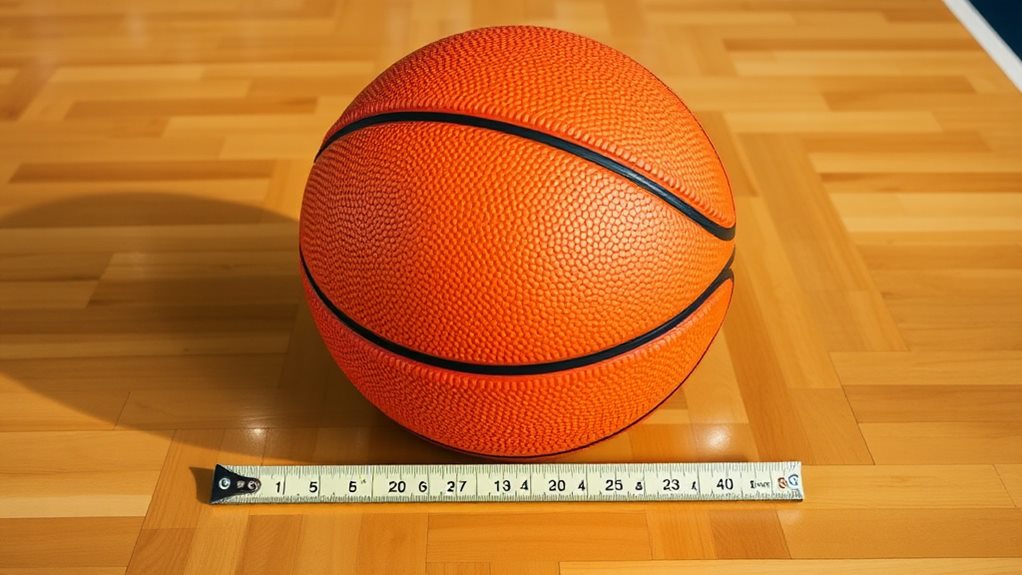
Understanding Size 7 Basketball Diameter: The Official Standard
November 26, 2024Understanding the Size 7 basketball's diameter is fundamental for recognizing official standards in the game. The diameter ranges from 9.43 to 9.51 inches, which guarantees that players aged 13 and older can develop essential skills like shooting accuracy and ball control. This size is standard across competitive leagues, like high school and the NBA, promoting consistency in gameplay. Shifting to this size from smaller balls is critical for improving your technique. By mastering the Size 7 specifications, you'll enhance your overall performance on the court, setting the stage for deeper insights into basketball regulations and player development.
Importance of Basketball Size
When it comes to basketball, the size of the ball you use can markedly impact your performance. The official size of a basketball, particularly the size 7, measures 29.5 inches in circumference and weighs approximately 22 ounces.
Utilizing the correct basketball size can enhance your gameplay, as data analytics have shown that ideal shot selection and grip are essential for developing proper shooting techniques data-driven strategies. If you play with a ball that's too small or too large, you might struggle with grip and control, leading to long-term negative effects on your skill set.
Different leagues have specific regulations regarding basketball size, and adhering to these rules can greatly influence your shooting accuracy and overall game performance.
Size 7 basketballs are commonly found in high school and travel leagues, offering you the necessary experience to shift smoothly into higher levels of competition.
Size 7 Basketball Specifications
A size 7 basketball is the standard for many competitive leagues, boasting a circumference of 29.5 inches (74.9 cm) and a weight of 22 ounces (623.7 grams). This size is specifically designed for players aged 13 and older, ensuring that they can develop their skills effectively.
When you pick up a size 7 basketball, you'll notice it provides an ideal grip and control, essential for advanced shooting techniques and gameplay. Understanding field dimensions and equipment is important in various sports, including basketball, as proper sizing enhances performance.
Here are some key specifications to keep in mind:
- Diameter: The diameter of a size 7 basketball ranges from 9.43 to 9.51 inches (24-24.2 cm).
- Usage: This basketball is the official size in men's professional leagues, including the NBA and men's college basketball.
- Skill Development: Size 7 basketballs are commonly used in high school and travel leagues, facilitating skill development for competitive play.
Understanding these specifications will help you recognize why the size 7 basketball is preferred for serious players. Its weight of 22 ounces and precise diameter enhance handling, ensuring you're fully equipped for success on the court.
Comparison With Other Sizes
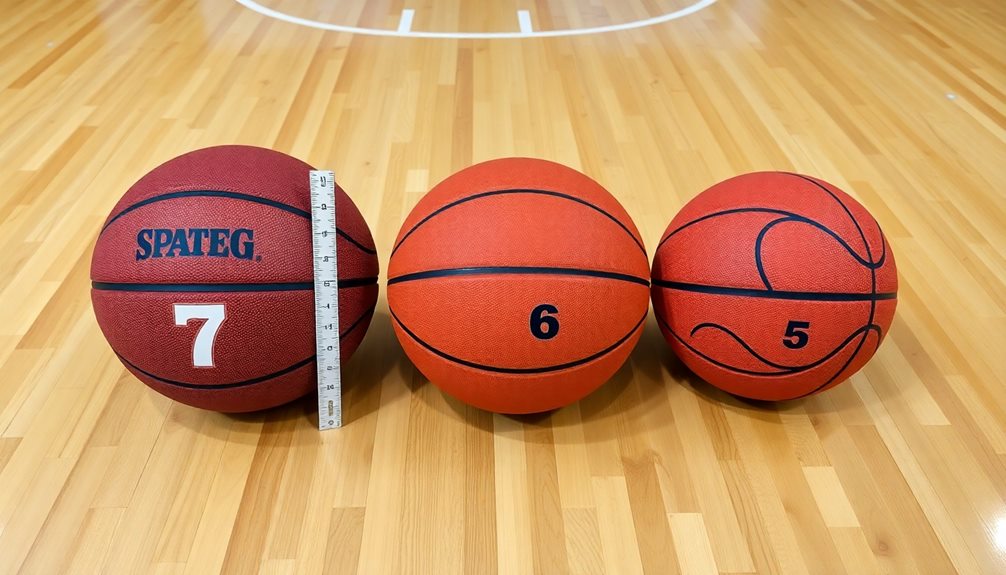
Comparing the size 7 basketball to others reveals significant differences in dimensions and intended user age groups. The size 7 ball, which boasts a circumference of 29.5 inches and a diameter of 9.43 to 9.51 inches, is designed for men's basketball leagues.
This is similar to how soccer players must understand their positions and the field to enhance gameplay, as detailed in the basic rules and structure of soccer.
In contrast, the size 6 basketball, used for women, measures 28.5 inches in circumference, resulting in a smaller diameter of 9.07 to 9.23 inches.
If you look at youth basketballs, the size 5 ball, targeted at players aged 9 and younger, has a circumference of 27.5 inches and a diameter of around 8.75 inches. This reduction in size can affect grip and control for younger players.
For even younger children aged 5-8, the size 4 basketball measures 25.5 inches in circumference and has a diameter of about 8.1 inches, making it easier to handle.
For toddlers aged 4 and under, the size 3 ball offers a circumference of 22 inches and a diameter around 7 inches, making it the smallest option available.
These variations in size guarantee that each group gets a ball that suits their physical capabilities and enhances their playing experience.
Official Regulations and Standards
Understanding the official regulations surrounding size 7 basketballs is vital for players, coaches, and officials alike. These standards guarantee fair play and consistency across various competitive levels, including high school basketball and travel leagues.
Recent advancements in material innovation have contributed to the development of size 7 basketballs, enhancing their durability and performance.
- The size 7 basketball measures 29.5 inches in circumference.
- It weighs approximately 22 ounces, which is the standard weight for peak performance.
- The required inflation pressure ranges from 7.5 to 8.5 PSI.
These official regulations define the size 7 basketball, with a diameter typically ranging from 9.43 to 9.51 inches. This consistency is significant for handling and gameplay, allowing players to develop and refine their skills effectively.
By adhering to these standards, you can maintain proper shooting techniques and ball control, which are vital for success on the court.
As you engage in high school basketball or any competitive league, understanding these regulations not only helps you comply with the rules but also enhances your performance.
When everyone plays with the same equipment, it levels the playing field and fosters a more enjoyable sporting environment.
Be sure to familiarize yourself with these official regulations to elevate your game!
Impact on Player Performance
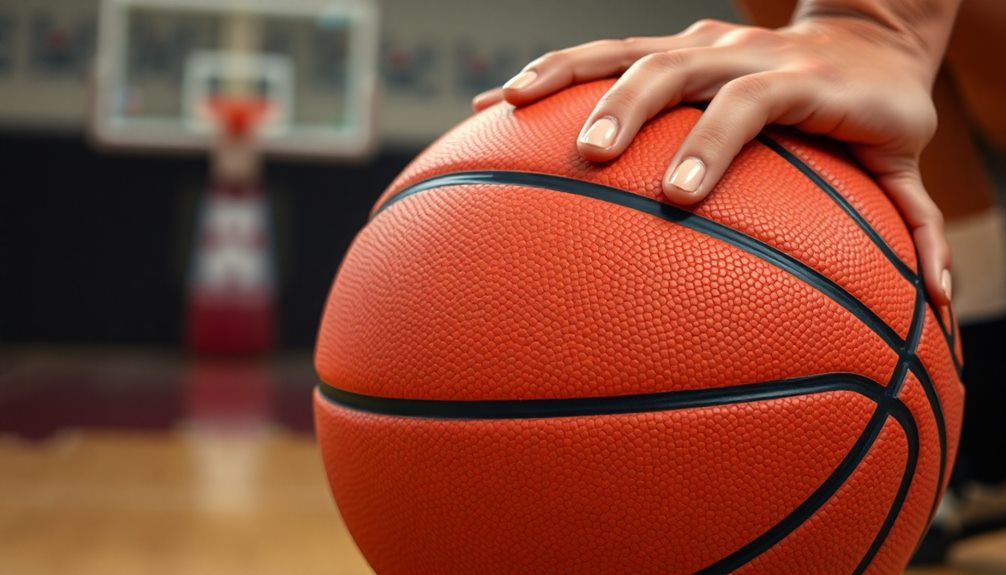
The size 7 basketball's precise dimensions and weight play a fundamental role in enhancing player performance on the court. With a circumference of 29.5 inches and a diameter of approximately 9.43 to 9.51 inches, this basketball is designed for ideal grip and control for players aged 15 and above.
When you practice with a size 7 basketball, you'll find that your shooting accuracy improves as you become accustomed to its dimensions, allowing you to refine your shooting mechanics over time. Additionally, incorporating regular drills to enhance your ball control and shooting techniques can further elevate your game, as consistency in practice is essential for skill development consistent effort is essential for refining skills.
The standard weight of 22 ounces is critical for developing proper shooting form. If you're using heavier balls, it can lead to poor technique unless you're adequately conditioned.
Practicing with a size 7 basketball is especially beneficial if you're aiming for competitive play in leagues like the NBA or men's college basketball, as it aligns with league standards. This consistency minimizes the risk of developing bad habits, ensuring you adapt your skills to the official size used in high-stakes games.
Ultimately, your dedication to mastering the size 7 basketball will greatly elevate your overall player performance, giving you a competitive edge on the court.
Choosing the Right Basketball
When selecting a basketball, it's vital to take into account the size that suits your playing level and age group. For players aged 15 and up, the Size 7 basketball, measuring 29.5 inches in circumference and weighing 22 ounces, is the official standard.
Choosing a basketball that fits you well can greatly enhance your grip, control, and shooting accuracy. Additionally, understanding the best formations for winning matches can help improve your overall strategy on the court.
Here are a few points to keep in mind when choosing a basketball:
- Adhere to league regulations: Different leagues have specific size requirements, so make sure you comply for competitive play.
- Practice with the right size: Shifting from youth leagues to a Size 7 basketball is vital for developing proper technique and avoiding bad habits.
- Focus on performance: Using the correct size basketball improves your overall game, ensuring you enjoy it more while honing your skills.
Material Types for Basketballs
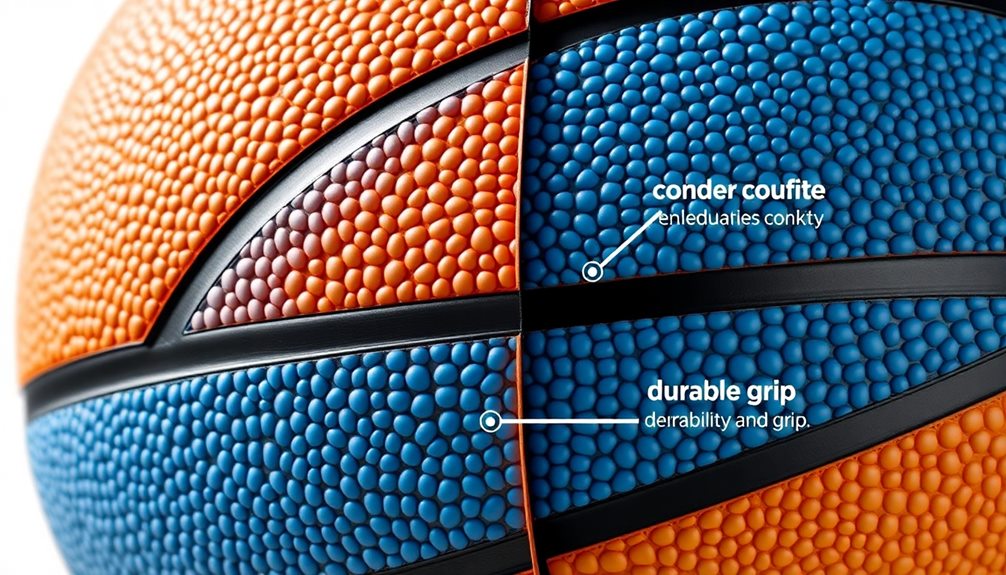
Basketballs come in various materials that cater to different playing environments and preferences. If you're looking for a durable option for outdoor courts, a rubber ball is your best bet. These balls are designed to withstand rough surfaces and changing weather conditions, making them the go-to choice for street basketball.
Additionally, selecting the right basketball size is essential for ideal performance, as improper sizing can affect your game proper sizing is essential.
For those who play both indoors and outdoors, composite leather basketballs offer the perfect balance. They're known for their durability and excellent grip, so you can easily shift between playing environments without missing a beat. Plus, they provide a good feel right out of the box.
If you're an indoor player seeking the best performance, you might want to invest in a full-grain leather basketball. These balls offer superior grip and feel once broken in, enhancing your shooting and ball-handling skills.
However, keep in mind that full-grain leather isn't suitable for outdoor use due to its tendency to wear down quickly on rough surfaces.
In choosing the right basketball material, consider where you'll be playing most often. Your choice can considerably impact your game experience and performance.
Inflation and Pressure Guidelines
When you're playing with a size 7 basketball, keeping it properly inflated is key to your performance.
The recommended pressure range of 7.5 to 8.5 PSI guarantees ideal grip and handling during the game.
This is similar to how VAR technology enhances accuracy in soccer officiating, where precision is vital for performance.
Regularly checking the inflation levels not only adheres to testing standards but also prevents any performance issues on the court.
Recommended Pressure Range
Maintaining the right inflation pressure is vital for the best performance of a Size 7 basketball. The recommended pressure range for this official ball is between 7.5 to 8.5 PSI. Proper inflation guarantees excellent grip and performance during play, allowing you to focus on your game rather than worrying about the ball's responsiveness.
Here are some key points to keep in mind:
- A well-inflated ball rebounds to 1,200-1,400 mm when dropped from a height of 1,800 mm.
- Consistent pressure is critical for fair play across different leagues, especially for men's ball competitions.
- Keeping the ball within the recommended pressure range prevents issues like poor shooting accuracy and reduced bounce.
Impact on Performance
Achieving the right inflation and pressure directly influences how a size 7 basketball performs on the court. An official size 7 ball, which spans a diameter of 9.43 to 9.51 inches, must be inflated to a pressure range of 7.5 to 8.5 PSI. This is essential for ideal grip and enhances your shooting and handling dynamics.
If you play with an under-inflated or over-inflated ball, you're likely to experience inconsistent performance characteristics, which can impact your game.
When properly inflated, a size 7 basketball rebounds impressively between 1,200 and 1,400 mm when dropped from 1,800 mm, showcasing its responsiveness during play. This responsiveness is critical for maintaining control and accuracy, especially in high-stakes moments.
Consistent pressure levels not only enhance your performance but also guarantee fairness and competitive integrity, allowing you to focus on your skills rather than worrying about the ball's feel.
Whether you're playing in a casual pickup game or a competitive league, keeping your size 7 ball properly inflated can markedly affect your overall level of play, making it a fundamental aspect of your basketball gear.
Testing and Regulation Standards
Consistency in testing and regulation standards is vital for guaranteeing that a size 7 basketball performs at its best during play. To achieve this, several guidelines are in place regarding inflation and pressure.
- Size 7 balls should weigh between 20 to 22 ounces.
- The air pressure for these balls must be maintained between 7.5 to 8.5 PSI.
- For FIBA, the ball must rebound between 1,200 to 1,400 mm when dropped from 1,800 mm.
These standards help guarantee that every size 7 basketball feels and behaves consistently during the game. Proper inflation is essential, as it affects the ball's grip, handling, and overall performance.
If a ball is under-inflated or over-inflated, it can lead to unpredictable bounces and diminished control, affecting gameplay considerably.
Moreover, adhering to the maximum weight and diameter specifications—ranging from 9.43 to 9.51 inches—guarantees a level playing field, allowing players to showcase their skills effectively.
Historical Context of Size 7
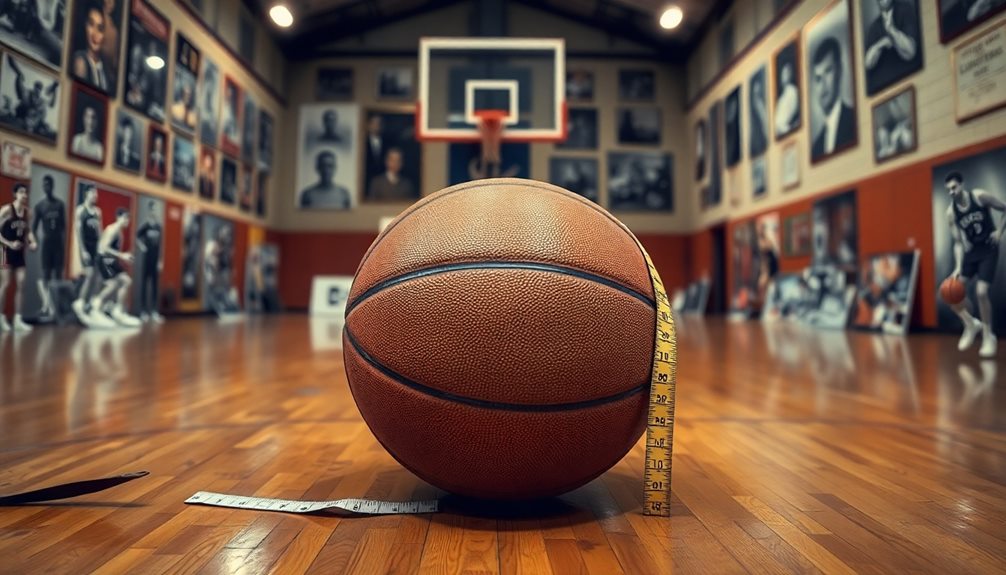
When you think about the size 7 basketball, it's important to recognize how its official standards have shaped the sport over time.
These guidelines not only standardized the game but also greatly impacted player performance, especially for those moving to competitive levels.
The evolution of sports standards, similar to the standardization of soccer rules, highlights the importance of uniformity in enhancing the overall experience.
Understanding this historical context can help you appreciate the role size 7 plays in modern basketball.
Evolution of Official Standards
The evolution of official standards for basketball, particularly the size 7 ball, reflects a blend of historical necessity and player development. Introduced in 1946, the size 7 basketball, measuring 29.5 inches in circumference and weighing 22 ounces, has become the standard in men's professional leagues like the NBA. This consistency guarantees that players can develop their skills effectively, regardless of the level of play.
Key aspects of the evolution include:
- The adoption of size 7 balls for men's college basketball, promoting uniformity across competitive levels.
- Historical regulations that influenced the shift to size 7 in high school and youth basketball leagues.
- The unchanged specifications over the years, emphasizing its importance for player growth and sport integrity.
This standardization accommodates the typical hand size and skill level of male players over the age of 15, providing an ideal balance for control and shooting accuracy.
By maintaining this consistent standard, basketball organizations support the development of players, paving the way for future generations to excel in the sport.
Understanding these historical contexts helps you appreciate the significance of the size 7 basketball in today's game.
Impact on Player Performance
Many players mightn't realize how crucial the size 7 basketball is to their performance on the court. With a circumference of 29.5 inches and a weight of 22 ounces, the Size 7 basketball is the official standard in men's professional leagues like the NBA. This consistency directly influences your gameplay, as it guarantees you're always working with the same size ball during training.
Historical data shows that players who train with the Size 7 basketball develop better shooting accuracy, grip, and overall ball control. This development leads to enhanced performance when it matters most.
The widespread adoption of the Size 7 ball in high school and travel leagues means you can shift seamlessly to higher levels of competition without adjusting to a different ball size.
Moreover, using the correct size basketball helps prevent poor shooting mechanics from forming, which can persist into adulthood. By emphasizing the Size 7 basketball in competitive play, you foster proper shooting form and technique, which are essential for success in high-pressure game situations.
Ultimately, understanding the impact of the Size 7 basketball on your training will remarkably elevate your performance on the court.
Recommendations for Players
For aspiring basketball players, using a Size 7 basketball is essential for your development on the court. Shifting to size 7 balls at the right age helps you align your skills with those used in professional leagues.
This practice not only enhances your grip and control but also improves shooting accuracy, leading to better performance overall. Engaging with a holistic development approach in your training can further amplify your skills, as it promotes not just physical prowess but also mental and social growth.
Here are some recommendations to maximize your training:
- Consistency is key: Regularly practice with the correct Size 7 basketball to develop muscle memory.
- Focus on technique: Use size 7 balls to master your shooting form and ball handling skills.
- Train with purpose: Incorporate drills that emphasize the unique characteristics of the Size 7 basketball.
Conclusion
So, you've mastered the art of dribbling a size 7 basketball—congratulations! You're now an expert in the world of official standards and inflated egos. Remember, whether you're sinking three-pointers or just shooting air balls, it's all about that perfect diameter. Forget the fate of the universe; the real question is: can you handle the pressure? So go ahead, take your shot, and may your basketball dreams be as inflated as the ball itself!


